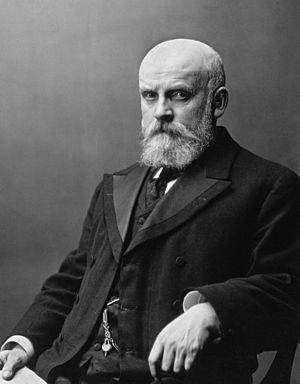John Russell Hind facts for kids
Quick facts for kids
John Russell Hind
|
|
|---|---|

John Russell Hind c. 1860s
|
|
| Born | 12 May 1823 |
| Died | 23 December 1895 (aged 72) Twickenham, London
|
| Known for | Discovery of asteroids and variable stars |
| Awards | Lalande Prize (1847, 1850–1854) Gold Medal of the Royal Astronomical Society (1853) Royal Medal (1855) |
John Russell Hind (born May 12, 1823 – died December 23, 1895) was an important English astronomer. He was known for finding many asteroids and special stars. He also held important jobs in the world of astronomy.
Contents
John Russell Hind's Life and Discoveries
Early Life and Career
John Russell Hind was born in 1823 in Nottingham, England. His father, John Hind, made lace. John Russell Hind went to Nottingham High School. When he was 17, he moved to London. He started training to become a civil engineer.
However, with help from Charles Wheatstone, he changed his path. He got a job at the Royal Observatory, Greenwich. This is a famous place where scientists study the stars. He worked there from 1840 to 1844. After that, he became the director of a private observatory. This observatory belonged to a man named George Bishop.
In 1853, John Hind took on another big role. He became the leader of the Nautical Almanac. This was a special book that helped sailors find their way using the stars. He kept this job until 1891.
Discovering Asteroids and Stars
John Russell Hind is famous for being one of the first people to discover asteroids. Asteroids are small, rocky objects that orbit the Sun. He found many of them!
He also found and studied variable stars. These are stars that change how bright they appear from Earth. Some of the stars he discovered include R Leporis, which is also called Hind's Crimson Star. He also found U Geminorum and T Tauri. T Tauri is sometimes called Hind's Variable Nebula. He also noticed that the star μ Cephei changed its brightness.
In 1848, Hind discovered a new bright star in the sky. It was called Nova Ophiuchi 1848. This was the first time such a star had been found since 1670.
Naming the Asteroid Victoria
One of the asteroids John Hind found was named 12 Victoria. This caused a bit of a discussion. Back then, asteroids were not supposed to be named after people who were still alive.
Hind said that the name wasn't for Queen Victoria. He claimed it was named after Victoria, a goddess from old stories.
In 1863, he became a special member of the Fellow of the Royal Society. This is a very important group for scientists. In 1880, he became the President of the Royal Astronomical Society. This meant he was the leader of a group of astronomers.
John Russell Hind passed away in 1895 in Twickenham, London. He had married Fanny Fuller in 1846. They had six children together.
| 7 Iris | 13 August 1847 | MPC |
| 8 Flora | 18 October 1847 | MPC |
| 12 Victoria | 13 September 1850 | MPC |
| 14 Irene | 19 May 1851 | MPC |
| 18 Melpomene | 24 June 1852 | MPC |
| 19 Fortuna | 22 August 1852 | MPC |
| 22 Kalliope | 16 November 1852 | MPC |
| 23 Thalia | 15 December 1852 | MPC |
| 27 Euterpe | 8 November 1853 | MPC |
| 30 Urania | 22 July 1854 | MPC |
Awards and Things Named After Him
John Russell Hind received many honors for his work.
- He won the Gold Medal of the Royal Astronomical Society in 1853.
- He became a Fellow of the Royal Society in 1863.
Many things in space were named after him to remember his discoveries:
- A crater on the Moon is called Hind.
- The asteroid 1897 Hind is named in his honor.
- Two comets, C/1847 C1 (Hind) and C/1846 O1 (de Vico-Hind), carry his name.
- The red-giant variable star R Leporis is known as Hind's Crimson Star.
- A special cloud of gas and dust in space, NGC 1555, is called Hind's Variable Nebula. It is near the young star T Tauri.


